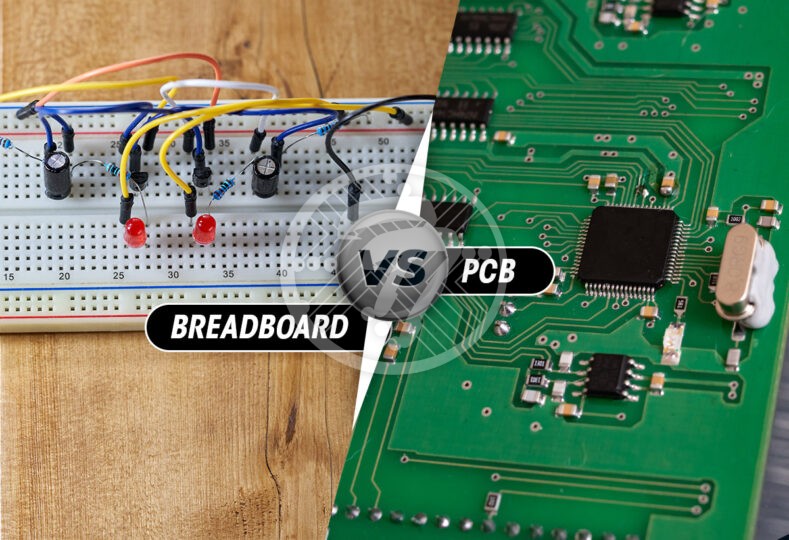PCB vs Breadboard – What is the difference?

A printed circuit board(PCB), which is an integral part of all electronic devices, is an electrical board that offers circuit connections. A wide variety of electronic components are soldered on the board depending on the bespoke requirements.
Breadboards, also referred to as protoboards, are solderless boards that are either single or double sided. These have holes that are used to put the terminals of components & wires. A key difference between the two is also that breadboards aren’t specific to a project. Breadboards derive their name from the fact that in the early days people made use of pieces of wood that they cut bread on to connect the circuits. Usually, breadboards comprise of four banks of thirty rows of holes.
Let us look at some of the differences between PCB vs Breadboard in detail:
PCB vs Breadboard – Key Differences
1. Components
A key difference between the two is that the components of a breadboard aren’t soldered and hence can be changed or removed. On the other hand, the components in the PCB are either surface mounted or through hole mounted and hence more permanent.
2. Phase of Operation
The use of breadboards is in the development phase while PCBs are used for final electronic products. With PCBs, therefore, it is imperative that they be designed as per the exact requirements and then be manufactured and assembled.
3. Carrying Capacity
When it comes to carrying capacity, PCBs are far superior than breadboards. In case of breadboards, since the components are connected by wires, the current carrying capacity is minimum. Additionally, when it comes to PCBs terminals can be added. The same, however, isn’t possible in case of breadboards.
4. Complexity
As opposed to PCBs, breadboards come with a simple structure. Even the simplest form of PCBs has a structure that is complex compared to breadboards. Typically, a breadboard comprises of distribution buses and holes. In case of a PCB, its structure has at its very minimum a substrate layer, a copper layer, solder mask & silkscreen.
5. Rigidity
While Breadboards are rigid, the key advantage with PCBs is that they could be rigid, flexible or rigid-flex, to suit a wide variety of requirements.
6. Support
As for the support offered by each of them, while breadboards support components mechanically, the support offered by PCBs is far more robust since it connects the circuitry mechanically as well as electrically.
7. Electrical Function
Breadboards perform no electrical function. In case of a PCB, however, there are a wide variety of functions such as transferring radio signals, dissipating heat, and more.
8. Look and feel
When it comes to the look and feel, PCBs are available in several different colors on account of the color of the silkscreen. The look and feel of breadboards, however, remain basic.
Between a PCB & a breadboard, which is superior?
It is hard to come to a one-size-fits-all answer to that question. This is because the usability really depends on your bespoke needs. If you are at the early developmental stages, breadboards work well. They are low in cost, offer reusability and more. As a hobbyist you in any case need to start with a breadboard and then move on to advanced projects. Even as a professional, you can use breadboards for troubleshooting, experiments and more. Breadboard is also used for easy prototyping. Another alternative to the breadboard is the perforated board. It is a thin piece panel that has lined up perforations. However, since the perforations have no electric connections, the components need to be connected through soldering or wire wrapping.
When you are looking at a permanent electric device, you sure need a more sophisticated device that is permanent and can withstand different environmental conditions. A PCB is a clear winner in such cases.
Can you turn a breadboard into a PCB?
It is important to remember that breadboards are the initial step before you develop a PCB. Breadboards work well for testing your schematics. Once this aspect is done, you need to generate Gerber Files for manufacturing of PCBs. The Gerber files are then sent to a professional PCB manufacturer, who then takes to fabricating and assembling the PCB.
We are fully equipped to handle your PCB manufacturing requirements. At Technotronix, we follow industry best practices to ensure we deliver cutting-edge products. In case if you have any questions, please feel free to contact us via email at [email protected] or fill out the form below to request a free quote now.






